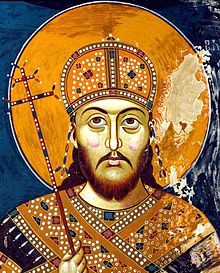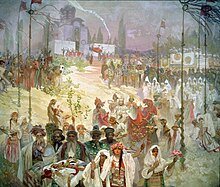Stefan Uroš IV. Dušan
Stefan Uroš IV. Dušan "the Mighty" ( Serbian : Стефан Урош IV Душан ; * 1308 ; † December 20, 1355 ), also known as Emperor Dušan , Dušan the Mighty / the Great (Dušan Silni) or Stefan Dušan , was a Serbian King (1331–1346) and first Serbian emperor (1346–1355) the most powerful monarch of the Nemanjić dynasty . Under his leadership, medieval Serbia rose to the status of a major regional power and drafted one of the first comprehensive constitutions in southern Europe known asDušanov zakonik .
His reign is now considered the Golden Age of Serbia , also with a view to the cultural, economic and social development during his reign. He died in Adrianople, today's Edirne , in 1355 during the campaign against the Byzantine Empire and was buried in the Archangel monastery near Prizren . In 1927 a team of archaeologists discovered a marble burial place in the ruins of the monastery , which was identified as the Dušan's. His bones were later transferred to St. Mark's Church in Belgrade .
Life
Tsar Dušan came from the Serbian noble house of the Nemanjids , which came to power in 1192. Therefore he was also Nemanjić IX. called. He was born in 1308 as the son of Stefan Uroš III. Dečanski and the Theodora Smilets of Bulgaria. In 1331 he usurped the throne from his father and, supported by nobles, rose himself to be King of Serbia . On September 8th he was crowned in Skopje. The capital of his empire was initially Prizren, and from 1345 Skopje . In 1332 he married Jelena, the sister of Tsar Ivan Asen Alexander of Bulgaria . On April 16, 1346 he was crowned "Tsar of Serbs and Rhomeans " in Skopje. The attempt to obtain the Byzantine crown also failed. In 1355 he died near Adrianople on the way to Constantinople .
Territorial extensions
Dušan put the Byzantine pretender Johannes Kantakuzenos back on the throne of Constantinople in 1341 and had him cede important cities and areas for this service. After he had got into a dispute with Kantakuzenos, he seized Macedonia and fought back the Ottoman Turks called for help against him by the Byzantine emperor and the Hungarians who rose against him under King Ludwig , conquered Belgrade , wrested Bosnia from an unruly ban and put it down Land under its own administration. Recognized as patron by the Republic of Ragusa in 1347 , he subjected a large part of Epirus , today's Albania , as well as Thessaly , Aetolia and Acarnania to his rule. He also made Bulgaria dependent on himself and assumed the title of tsar and "Emperor of the Rhomeans" (Romans). Administratively, Dušan divided his empire into the "Serbian" or "royal lands" with Prizren as the capital, which he nominally subordinated to his son Uroš, and into the "Roman" (also Greek) or "imperial lands" with Serres as the capital, which directly were subject to his rule. The exact division between these two administrative units is not known today, it is believed to be around Skopje. Skopje remained the capital of the empire, although Dušan ruled from Serres in his final years.
Foundation of a Serbian national church
In order to ward off foreign spiritual influence, but ostensibly to be crowned emperor, for which he could not count on the support of the Patriarch of Constantinople , Dušan induced the clergy of his country to elect their own patriarch at a synod at Phera. In the year 1346 Stefan was crowned tsar by the Bulgarian patriarch Symeon von Trnovo in Skopje , at the same time he made the head of the Serbian church the first Serbian patriarch Joanikije II . The Serbian Church thus became its own patriarchy within the Eastern Church , and Peć became the patriarchal seat . The Patriarch of Constantinople banned Stefan Dušan and the Serbian Patriarch, the Bulgarian-born Joanikije II., With the church ban, which was lifted in 1375. Dušan was not deterred by the excommunication, as he saw it as a political reaction by the emperors in Constantinople. Like Charlemagne , he resorted to the east-west division of the Roman Empire and presented himself as "Emperor of the West", the emperors in Constantinople as Emperor of the East. In fact, in territorial terms, Dušan's empire corresponded in many ways to Illyricum Prefecture from the time of the Roman Tetrarchy . The administrative division into the royal and imperial lands under Dušan is also reminiscent of that of the Illyrian prefecture into the dioceses of Dacia and Macedonia. Dušan now used as the full rulership title: By the grace of God, Stefan, the orthodox and Christ-loving emperor of the Serbs and Greeks [literally Romans ] , the Albanians [literally Arvanites ] , Bulgarians and Romanians [literally Bessarabs ] , the coastal countries and the entire West .
Church union and the arrival of the Ottomans
Dušan had had unpleasant experiences several times with Turkish aid armies fighting for Byzantium. In the Battle of Stefaniana in 1344, the cavalry of the Turkish Beylik von Aydın lured Dušan's elite armed forces into an ambush and defeated them. In the Battle of Demotika in 1352, the Serbian cavalry was defeated by the Ottoman forces . Before that, the Bulgarian auxiliary troops on the Serbian side had left the fighting. After a severe earthquake in 1354, the Ottomans finally conquered Gallipoli and gained a foothold in Europe.
Dušan had correctly seen the danger that the Ottomans would soon represent and turned to Pope Innocent VI. He was ready to agree to a church union in his kingdom, for which he wanted to be appointed by the Pope as "captain of Christianity in the fight against the infidels". This venture was welcomed by the Roman-German King Charles IV . Dušan again hoped for guarantees against further attacks on the part of the northern neighbor Hungary, on the other hand he saw himself at the head of a possible crusade against the Turks. Innocent VI. sent an embassy under the leadership of Peter Thomas . Contrary to what was expected, he insisted not only on church union, but on Dušan converting entirely to the Roman Catholic faith. When Catholic Hungary began a campaign against its empire around 1355, Dušan no longer wanted to know anything about the union with Rome and informed the papal embassy. Petrus Thomas left Dušan's court angry. According to tradition, both had provoked each other. The negotiations had failed. On his return trip through Hungary, Thomas recommended the Hungarian King Ludwig I to “take action against the schismatics without mercy”.
Marriage courtship for Habsburg
In 1336 Dušan planned to separate from his wife Jelena, as the marriage with her remained childless. A marriage with Elisabeth, the daughter of Frederick the Fair , was promised . The leader of his German mercenary troops, Palman Bracht , was sent as a matchmaker because of his German language and his previous services for the Habsburgs. However, Palman's advertisements were unsuccessful because Elisabeth died early.
death
Stefan Dušan died on December 20, 1355 near Adrianople, today's Edirne , at the age of 48. The cause of his death has never been clarified; poisoning, stroke or epilepsy are suspected. He was buried in his monastery foundation, the Archangel Monastery near Prizren . In 1927 a team of archaeologists discovered a looted marble burial place in the ruins of the monastery, which was identified as that of the tsar. The bones were later transferred to St. Mark's Church in Belgrade .
effect
Economic progress
Stefan Uroš IV. Dušan successfully promoted agriculture and mining, trade and commerce. Wide-ranging economic and trade relations fall into his epoch, from the Danube region to the Adriatic region to Venice . He promoted the economy by bringing foreign specialists into the country - Saxon miners, for example for mining and fortress construction, Dubrovnians (then Ragusans ) for trade, as well as Venetians and Greeks.
Law Book, Art and Literature
In 1349 Tsar Dušan published the first comprehensive Serbian code of law with 135 paragraphs . In 1354 it was revised again by him and 136 paragraphs were added. The code is considered to be the first comprehensive constitution of the Serbian medieval state and is one of the oldest constitutions in human history. The role of the Serbian emperors and kings as defenders of the Orthodox Church and Christianity is laid down in it, they are obliged to fight heresy .
The beginnings of secular Serbian literature based on folk songs also fall in this epoch - as a supplement to church literature.
Under the reign of Stefan Dušan, a. the construction of the Visoki Dečani monastery was completed and the archangel monastery was built at Prizren, which was also intended to serve as a burial place and was best known for its floor mosaic, which stylistically came very close to the cosmatic style . A western influence was also evident on Dušan's tomb, which - unique for Serbian and Orthodox Christian art at the time - had a grave figure of Dušan.
See also
literature
- Frank Kämper : Dušan, Stefan . In: Biographical Lexicon on the History of Southeast Europe. Volume 1. Munich 1974, pp. 449-451.
- Slavomir Nastasijevič: Stefan Dušan . Narodna Knjiga, Belgrade 1987, ISBN 86-331-0230-7 .
- Dushan . In: Meyers Konversations-Lexikon . 4th edition. Volume 5, Verlag des Bibliographisches Institut, Leipzig / Vienna 1885–1892, p. 251.
Web links
Individual evidence
- ↑ Dennis P. Hupchick, Conflict and chaos in Eastern Europe , New York, 1995, p. 141
- ↑ See : Konstantin Jireček, Geschichte der Serben , I, Gotha: 1911, pp. 387–9; http://bg-patriarshia.bg/index.php?file=tarnovo_patriarchs.xml
| predecessor | Office | successor |
|---|---|---|
| Stefan Uroš III. |
King of Serbia from 1346 Tsar 1331-1355 |
Stefan Uroš V. |
| personal data | |
|---|---|
| SURNAME | Stefan Uroš IV. Dušan |
| ALTERNATIVE NAMES | Stephan Dushan; Nemanjitsch IX .; Стефан Урош IV Душан (Serbian) |
| BRIEF DESCRIPTION | Ruler of Serbia (1331-1355) |
| DATE OF BIRTH | 1308 |
| DATE OF DEATH | December 20, 1355 |



